
Electric vehicle (EV) batteries are primarily made of several key components, each contributing to their functionality and performance. The main components include:
Lithium-Ion Cells: The core of EV batteries consists of lithium-ion cells. These cells contain lithium compounds that store and release electrical energy. The cathode and anode materials within these cells vary; common materials include lithium nickel manganese cobalt oxide (NMC), lithium iron phosphate (LFP), lithium cobalt oxide (LCO), and lithium manganese oxide (LMO).
Electrolyte: The electrolyte in lithium-ion batteries is typically a lithium salt dissolved in a solvent, serving as the medium for ion movement between the cathode and anode.
Separator: A separator, often made of a porous material like polyethylene or polypropylene, separates the cathode and anode, preventing electrical shorts while allowing ions to pass through.
Casing: The cells are enclosed within a casing, usually made of aluminum or steel, providing protection and structural integrity.
Cooling Systems: Many EV batteries have cooling systems to manage temperature, ensuring optimal performance and longevity. These systems can use liquid cooling or air cooling mechanisms.
Electronic Control Unit (ECU): The ECU manages and monitors the battery's performance, ensuring efficient charging, discharging, and overall safety.
The exact composition and materials can vary among different EV manufacturers and battery types. Researchers and manufacturers continually explore new materials and technologies to enhance battery efficiency, energy density, and overall lifespan while reducing costs and environmental impact.

Post time: Dec-20-2023





